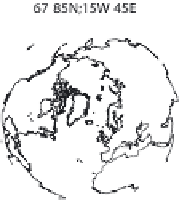Geoscience Reference
In-Depth Information
Figure A1.
ECBILT-CLIO-computed sawtooth pulses of surface air temperature at 2 m (T2M) for different boundary
conditions and averaged over the region shown. No external time-varying forcing is used. Three parameters (albedo dA,
orbital dO, and greenhouse gas dG) can be set to either preindustrial (PI) or last glacial maximum (LGM) conditions. The
eight combinations are displayed in order of increasing mean temperature from coldest LGM to warmest PI. The time
series are labeled according to what PI parameter is switched to the LGM condition. For instance, starting with all
conditions being PI, switching only albedo to LGM is labeled dA; switching both albedo and greenhouse gas to LGM is
labeled dAdG, and so on. Notice that all but PI and LGM show climate bistability, consistent with the D-O-oscillations.
The results are also consistent with the often stated idea that millennial-scale oscillations are most pronounced during times
of intermediate ice volume. Sampling rate is 1.0 year
1
. A mean (average) smoothing window five-point half width was
used in all time series. See details of the water column behavior for the dA condition in Figure 2. Modified from the work
of Rial and Saha [2008].
guide toward one or can be suggestive of one, as in fact
Friedrich et al. [2010] do by suggesting that obliquity forc-
ing crucially modulates the strength of feedback between sea
ice and convection that affects the Greenland, Icelandic, and
Norwegian seas overturning circulation and the AMOC.
However, they make these assertions based solely on mod-
eling results, without data to support them.
All climate models are wrong by virtue of being incom-
plete (some certainly more than others). Therefore, one uses
their best features and diligently checks their consistency
with other models that one knows in full detail (e.g., SIO)
and with the data. For instance, both ECBILT-CLIO and SIO
reproduce the subtle phase relationship between shallow and
deep ocean proxies (Figures 8 and 9). This is highly sugges-
tive because the relationship is precisely what Saltzman
'
s
model [Saltzman et al., 1981] predicts and the phenomenon
on which is based. Obviously, there is no Hudson Strait in
SIO; neither are there ice sheets.
In our experience, ECBILT-CLIO
“
tuned
”
to our needs is
self-consistent, has never produced contradictory results, and
is remarkably consistent with the data and even with well-
known [e.g., Shackleton et al., 2000] but poorly understood
observations (Figures 8, 9, and A2). For instance, we have
known for years that if the full topography of the ice sheets is

















































Search WWH ::

Custom Search